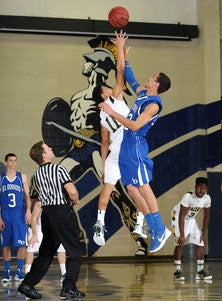Potential athletic career-ending injuries can be prevented with a few easy steps.
I see it at the beginning of basketball season every single year. Like clockwork after a week or a week and a half of hard practice it shows up.
The dreaded jumpers knee that has restricted and limited athletes for years has become all too common in sports. Why should athletes miss practice time and underperform because of a very simple injury to comprehend and prevent?

Jumpers knee typically comes up earlyin the season but can be prevented.
Photo by David Steutel
First let's identify the few factors that directly contribute to jumpers knee, in no specific order:
• Increased quadriceps strength from intense lower body training, especially in athletes who have made large strength increases in one offseason.
• Explosive leaping ability.
• Poor conditioning due to inactivity or weight gain.
• Poor flexibility and reduced hip mobility.
There's a reason why you typically see jumpers knee in the beginning of the season or after a volume stretch of multiple games in a short period of time. Your quadriceps either become stronger from weight training or tighter from flexibility issues and begin to pull on the physical knee cap which then strains a tendon that covers the knee and results in knee pain.
While acute jumpers knee isn't a big problem, if you allow it to continually appear each year without eliminating it permanently it can actually end your athletic career. In the short term it's always a good idea to just limit all activity until your knee pain subsides but that doesn't eliminate the problem. Here's a few simple steps to preventing, correcting and ending jumpers knee forever.
STEP ONE: Improve hip flexibility and mobility
Provided that there's nothing structurally wrong with the actual knee joint, treating acute jumpers knee is often as easy as improving your flexibility and mobility in your hips. Don't just stretch your quadriceps however. Our body works in opposites: if you stretch your quadriceps too much your hamstrings will lock up and limit your quadriceps' range of motion. This will still lead to reduced knee extension and flexion and overload the joint.
Any traditional quadriceps and hamstring stretches will work, provided you do them religiously. I recommend that you start with two to three stretches per muscle group for 30-45 seconds. Perform these stretches twice per day but if the problem persists start stretching for longer periods of time.
STEP TWO: Start training eccentricallyEccentric training has been proven to be very helpful for reducing various forms of tendonitis, especially jumpers knee. Eccentric contractions lead to faster muscle micro tearing that is related to muscle remodeling and tendon healing. This is the same reason that people who perform eccentrics feel a different degree of soreness the day after.
What movements should you perform? Well it depends on the movements that cause pain as we obviously want to avoid them completely. But simply holding onto a door handle and slowly lowering yourself into a single leg squat will go a long way in helping you.
STEP THREE: Increase your anti-inflammatory nutrition
At its base, jumpers knee is a result of local inflammation of various tendons surrounding the knee. Increase your chances of healing faster by incorporating some anti-inflammatory nutrition into your daily routine. Generally speaking you want to reduce all starchy carbohydrate in your diet while increasing healthy fats such as omega-3 fish oil, olive oil and avocados. In addition you want to replace all sugary drinks and soda with any combination of coffee, green tea and black tea. Don't go too overboard with it but make these subtle nutrition modifications and you'll notice faster recovery.
Jimmy Smith, MS, CSCS, is a performance therapist and nutritional consultant based in Stamford, Conn. He offers various online consulting services on his website.